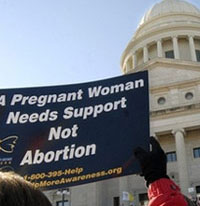This week the Ninth Circuit Court of Appeals struck down Arizona’s law prohibiting abortion at or after 20 weeks of pregnancy – a law that was based on uncontroverted medical evidence that abortion’s risks to maternal health increase dramatically at 20 weeks gestation.
It is universally accepted that risks to maternal health from abortion increase as pregnancy progresses. There is no debate on that fact, and peer-reviewed evidence utilized by the Arizona Legislature demonstrated that abortion imposes significant risks of harm beginning at 20 weeks gestation.
 In fact, in his concurring opinion in this case, Isaacson v. Horne, Judge Andrew J. Kleinfeld noted that the risks are indeed considerably greater after 20 weeks, and that the state presented substantial medical evidence to support its legislative findings.
In fact, in his concurring opinion in this case, Isaacson v. Horne, Judge Andrew J. Kleinfeld noted that the risks are indeed considerably greater after 20 weeks, and that the state presented substantial medical evidence to support its legislative findings.
In other words, a woman seeking an abortion at 20 weeks is 35 times more likely to die from abortion than she was in the first trimester. At 21 weeks or more — still before the child becomes viable — she is 91 times more likely to die from abortion than she was in the first trimester.
These are the same numbers relied upon by the pro-abortion Guttmacher Institute. In fact, in its “Facts on Induced Abortion in the United States,” Guttmacher emphasizes the increased risk of death by setting it apart in the text, because the numbers are actually quite startling:
The risk of death associated with abortion increases with the length of pregnancy, from one death for every one million abortions at or before eight weeks to one per 29,000 at 16–20 weeks — and one per 11,000 at 21 or more weeks.
But these data did not matter to the three-judge panel in Isaacson. That panel strictly applied the “viability” rule stemming from Roe v. Wade, claiming that no state can prohibit abortion before viability (around 23 to 24 weeks), regardless of whether later-term abortion substantially increases the mother’s risk of death.
The Ninth Circuit’s stance, albeit incorrect, is clear: Despite the fact that both sides agree that abortion at or after 20 weeks greatly increases the risk of maternal death, the “right” to abortion is more important than the lives of women.
But such adherence to a strict “viability” rule is not at all what the U.S. Supreme Court intended.
In fact, the Court made clear in Roe v. Wade, Planned Parenthood v. Casey, and Gonzales v. Carhart that the state has a legitimate interest in protecting maternal health from the outset of pregnancy — not just from the time the unborn child reaches viability.
And this legitimate interest in protecting maternal health is emphasized by the Court’s reasoning in the Gonzales decision, which concluded that state legislatures are to be given “wide discretion” to regulate abortion when there is “medical uncertainty” as to the safety of the procedure.
Here, there is no “medical uncertainty.” It is undisputed that the risk of complications and even death increases substantially at and after 20 weeks gestation. But the Ninth Circuit clung to the outdated “viability rule” while ignoring portions of Supreme Court’s abortion jurisprudence that did not comport with its desired result.
Judge Kleinfeld’s concurring opinion provides some hope that future abortion bans predicated on medical evidence and legitimate concern for women’s health will be upheld. He implied that his hands were tied by the “viability rule,” but noted that it is an odd rule because viability changes as medicine advances. The judge also acknowledged that the state and its amici made good arguments as to why the timeline of viability should not be the standard in abortion law.
CLICK LIKE IF YOU’RE PRO-LIFE!
In the meantime, what we see in the Isaacson decision is what we have expected all along: Medical data and techniques are vastly outpacing the outdated assumptions of Roe and its progeny — and many on the bench are refusing to catch up, instead clinging incoherently to the “right” to abortion at the expense of women’s health and welfare.
LifeNews.com Note: Mailee Smith is a staff counsel at Americans United for Life where this column originally appeared.







